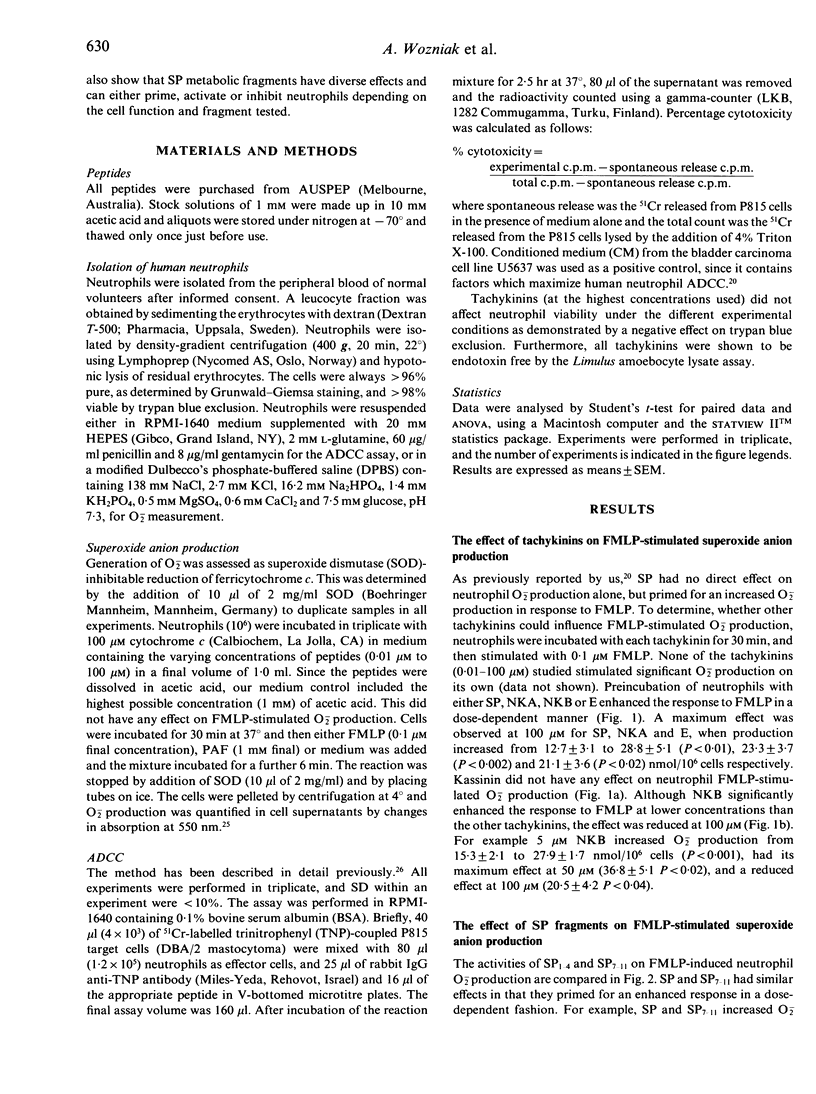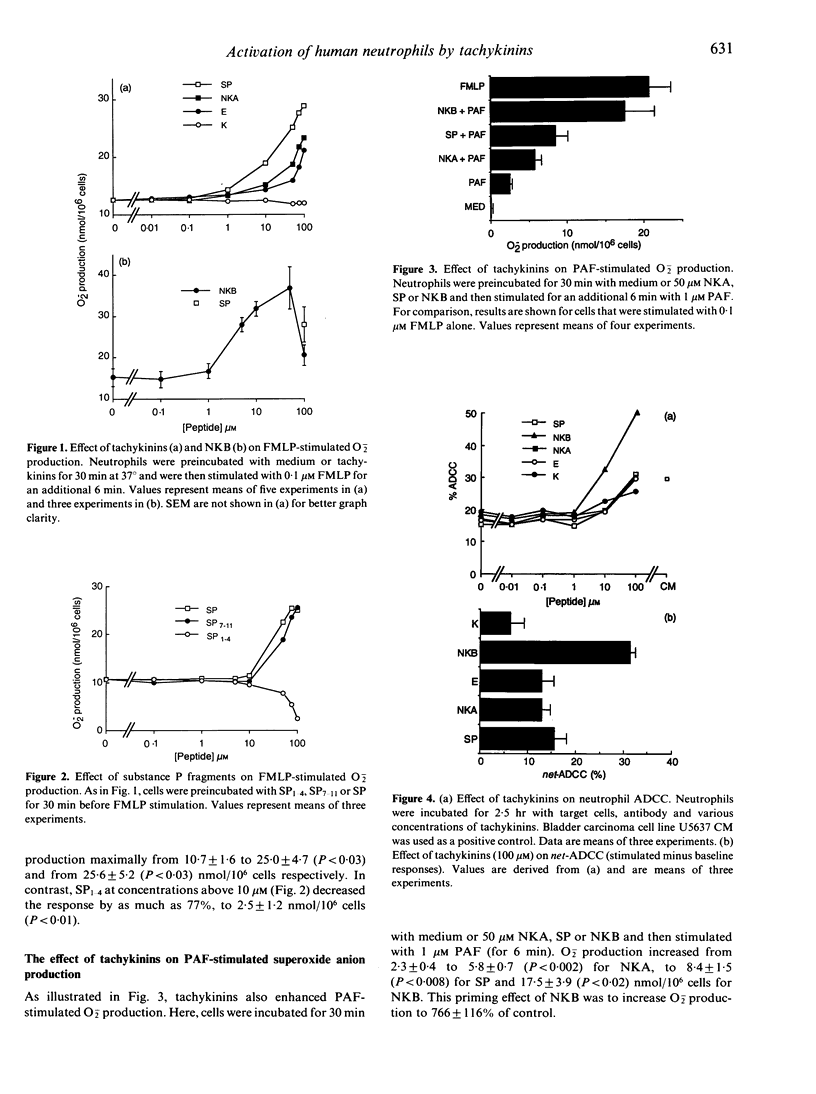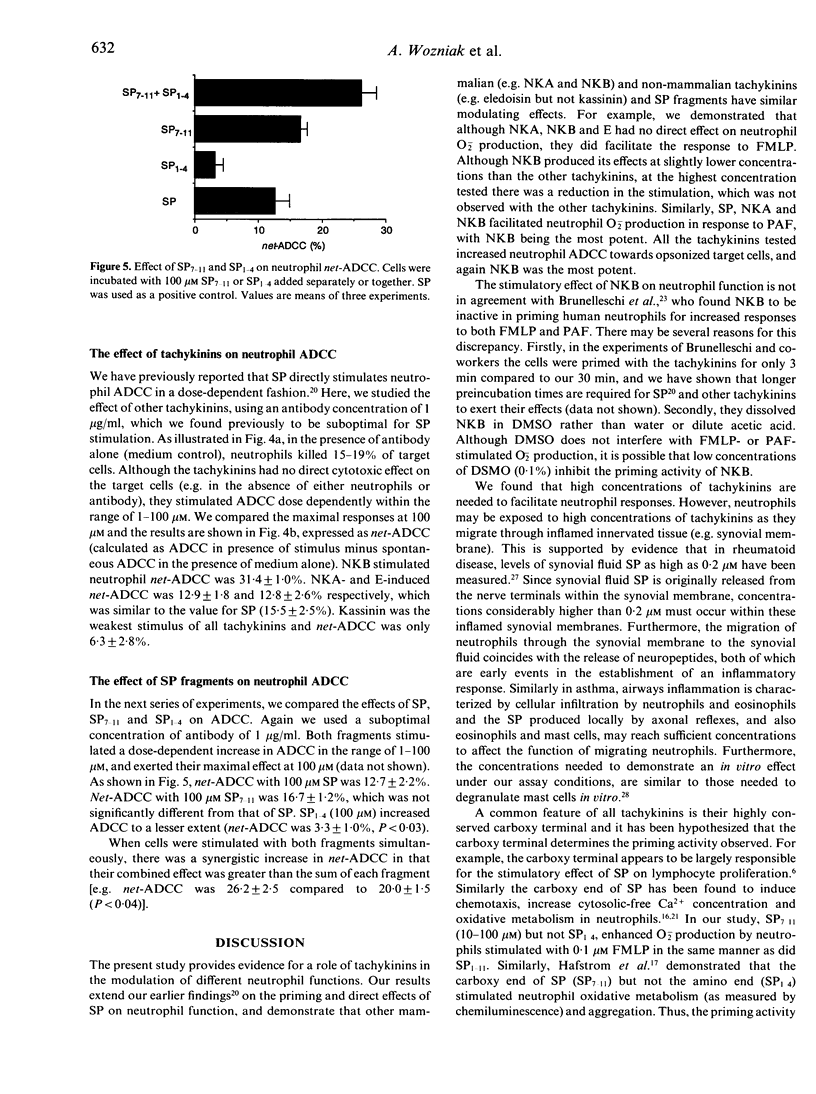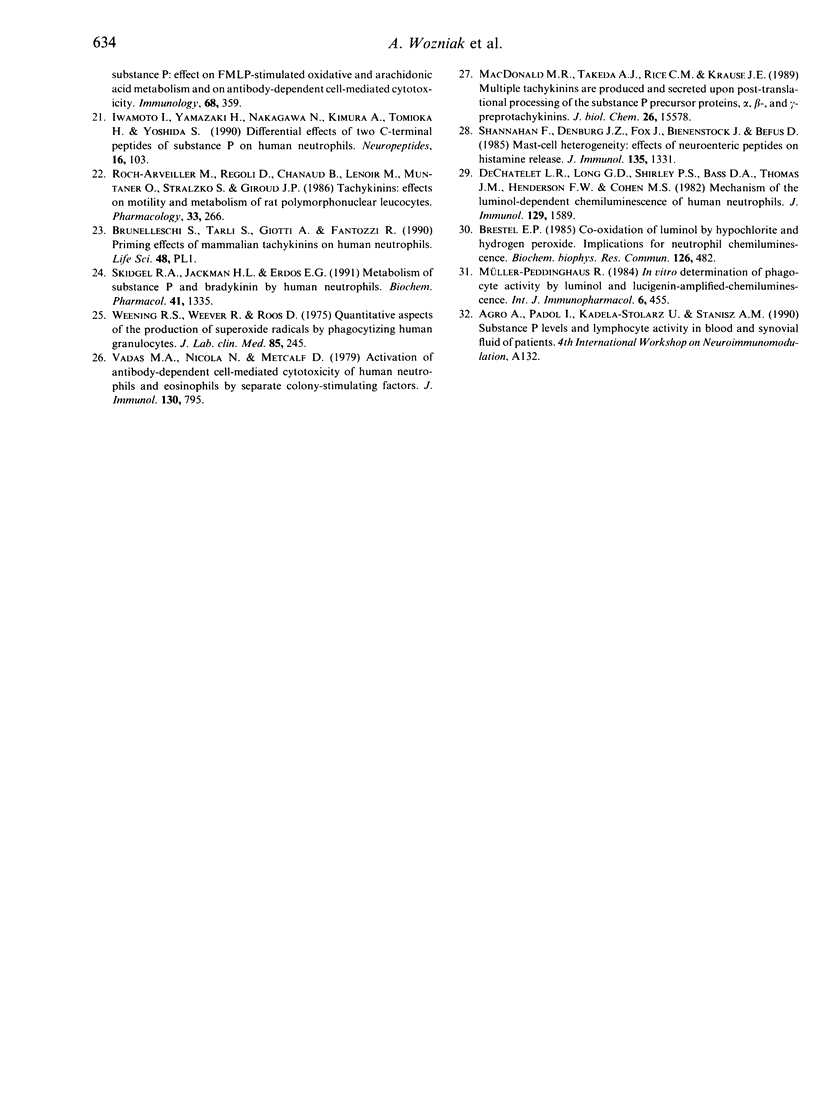Abstract
This study examines the contribution of tachykinins to the processes of inflammation. Neurokinin A (NKA), neurokinin B (NKB) and eledoisin (E) but not kassinin (K) have similar effects to substance P (SP) in priming neutrophils for increased superoxide anion (O2-) production in response to formyl-methionyl-leucyl-phenylalanine (FMLP). This similarity in activity may be due to the carboxy amino acid terminal end of these tachykinins being highly conserved. This was confirmed by demonstrating that SP fragment 7-11 (SP7-11) had the same priming effect as the whole molecule, whereas, the amino end fragment 1-4 (SP1-4) inhibited the response to FMLP. The priming effect of tachykinins was not confined to a single stimulus, such as FMLP, since NKA, NKB and SP also enhanced O2- production stimulated by platelet-activating factor (PAF), an important mediator of inflammation but a weak stimulus of O2- production on its own. In addition, all the tachykinins studied increased neutrophil antibody-dependent cell-mediated cytotoxicity (ADCC) towards opsonized target cells. In contrast to their effects on FMLP-induced O2- production, both SP fragments, SP1-4 and SP7-11, stimulated neutrophil ADCC and had a synergistic effect when used together.
Full text
PDF





Selected References
These references are in PubMed. This may not be the complete list of references from this article.
- Bar-Shavit Z., Goldman R., Stabinsky Y., Gottlieb P., Fridkin M., Teichberg V. I., Blumberg S. Enhancement of phagocytosis - a newly found activity of substance P residing in its N-terminal tetrapeptide sequence. Biochem Biophys Res Commun. 1980 Jun 30;94(4):1445–1451. doi: 10.1016/0006-291x(80)90581-1. [DOI] [PubMed] [Google Scholar]
- Brestel E. P. Co-oxidation of luminol by hypochlorite and hydrogen peroxide implications for neutrophil chemiluminescence. Biochem Biophys Res Commun. 1985 Jan 16;126(1):482–488. doi: 10.1016/0006-291x(85)90631-x. [DOI] [PubMed] [Google Scholar]
- DeChatelet L. R., Long G. D., Shirley P. S., Bass D. A., Thomas M. J., Henderson F. W., Cohen M. S. Mechanism of the luminol-dependent chemiluminescence of human neutrophils. J Immunol. 1982 Oct;129(4):1589–1593. [PubMed] [Google Scholar]
- Fewtrell C. M., Foreman J. C., Jordan C. C., Oehme P., Renner H., Stewart J. M. The effects of substance P on histamine and 5-hydroxytryptamine release in the rat. J Physiol. 1982 Sep;330:393–411. doi: 10.1113/jphysiol.1982.sp014347. [DOI] [PMC free article] [PubMed] [Google Scholar]
- Foreman J. C., Piotrowski W. Peptides and histamine release. J Allergy Clin Immunol. 1984 Aug;74(2):127–131. doi: 10.1016/0091-6749(84)90274-4. [DOI] [PubMed] [Google Scholar]
- Hafström I., Gyllenhammar H., Palmblad J., Ringertz B. Substance P activates and modulates neutrophil oxidative metabolism and aggregation. J Rheumatol. 1989 Aug;16(8):1033–1037. [PubMed] [Google Scholar]
- Hartung H. P., Wolters K., Toyka K. V. Substance P: binding properties and studies on cellular responses in guinea pig macrophages. J Immunol. 1986 May 15;136(10):3856–3863. [PubMed] [Google Scholar]
- Helke C. J., Krause J. E., Mantyh P. W., Couture R., Bannon M. J. Diversity in mammalian tachykinin peptidergic neurons: multiple peptides, receptors, and regulatory mechanisms. FASEB J. 1990 Apr 1;4(6):1606–1615. [PubMed] [Google Scholar]
- Iwamoto I., Yamazaki H., Nakagawa N., Kimura A., Tomioka H., Yoshida S. Differential effects of two C-terminal peptides of substance P on human neutrophils. Neuropeptides. 1990 Jun;16(2):103–107. doi: 10.1016/0143-4179(90)90119-j. [DOI] [PubMed] [Google Scholar]
- Kimball E. S., Persico F. J., Vaught J. L. Substance P, neurokinin A, and neurokinin B induce generation of IL-1-like activity in P388D1 cells. Possible relevance to arthritic disease. J Immunol. 1988 Nov 15;141(10):3564–3569. [PubMed] [Google Scholar]
- Lotz M., Vaughan J. H., Carson D. A. Effect of neuropeptides on production of inflammatory cytokines by human monocytes. Science. 1988 Sep 2;241(4870):1218–1221. doi: 10.1126/science.2457950. [DOI] [PubMed] [Google Scholar]
- MacDonald M. R., Takeda J., Rice C. M., Krause J. E. Multiple tachykinins are produced and secreted upon post-translational processing of the three substance P precursor proteins, alpha-, beta-, and gamma-preprotachykinin. Expression of the preprotachykinins in AtT-20 cells infected with vaccinia virus recombinants. J Biol Chem. 1989 Sep 15;264(26):15578–15592. [PubMed] [Google Scholar]
- Müller-Peddinghaus R. In vitro determination of phagocyte activity by luminol- and lucigenin-amplified chemiluminescence. Int J Immunopharmacol. 1984;6(5):455–466. doi: 10.1016/0192-0561(84)90084-5. [DOI] [PubMed] [Google Scholar]
- Payan D. G., Brewster D. R., Goetzl E. J. Specific stimulation of human T lymphocytes by substance P. J Immunol. 1983 Oct;131(4):1613–1615. [PubMed] [Google Scholar]
- Perianin A., Snyderman R., Malfroy B. Substance P primes human neutrophil activation: a mechanism for neurological regulation of inflammation. Biochem Biophys Res Commun. 1989 Jun 15;161(2):520–524. doi: 10.1016/0006-291x(89)92630-2. [DOI] [PubMed] [Google Scholar]
- Roch-Arveiller M., Regoli D., Chanaud B., Lenoir M., Muntaner O., Stralzko S., Giroud J. P. Tachykinins: effects on motility and metabolism of rat polymorphonuclear leucocytes. Pharmacology. 1986;33(5):266–273. doi: 10.1159/000138225. [DOI] [PubMed] [Google Scholar]
- Ruff M. R., Wahl S. M., Pert C. B. Substance P receptor-mediated chemotaxis of human monocytes. Peptides. 1985;6 (Suppl 2):107–111. doi: 10.1016/0196-9781(85)90142-1. [DOI] [PubMed] [Google Scholar]
- Scicchitano R., Biennenstock J., Stanisz A. M. In vivo immunomodulation by the neuropeptide substance P. Immunology. 1988 Apr;63(4):733–735. [PMC free article] [PubMed] [Google Scholar]
- Serra M. C., Bazzoni F., Della Bianca V., Greskowiak M., Rossi F. Activation of human neutrophils by substance P. Effect on oxidative metabolism, exocytosis, cytosolic Ca2+ concentration and inositol phosphate formation. J Immunol. 1988 Sep 15;141(6):2118–2124. [PubMed] [Google Scholar]
- Shanahan F., Denburg J. A., Fox J., Bienenstock J., Befus D. Mast cell heterogeneity: effects of neuroenteric peptides on histamine release. J Immunol. 1985 Aug;135(2):1331–1337. [PubMed] [Google Scholar]
- Shibata H., Mio M., Tasaka K. Analysis of the mechanism of histamine release induced by substance P. Biochim Biophys Acta. 1985 Jul 30;846(1):1–7. doi: 10.1016/0167-4889(85)90102-8. [DOI] [PubMed] [Google Scholar]
- Skidgel R. A., Jackman H. L., Erdös E. G. Metabolism of substance P and bradykinin by human neutrophils. Biochem Pharmacol. 1991 May 1;41(9):1335–1344. doi: 10.1016/0006-2952(91)90106-f. [DOI] [PubMed] [Google Scholar]
- Stanisz A. M., Befus D., Bienenstock J. Differential effects of vasoactive intestinal peptide, substance P, and somatostatin on immunoglobulin synthesis and proliferations by lymphocytes from Peyer's patches, mesenteric lymph nodes, and spleen. J Immunol. 1986 Jan;136(1):152–156. [PubMed] [Google Scholar]
- V Euler U. S., Gaddum J. H. An unidentified depressor substance in certain tissue extracts. J Physiol. 1931 Jun 6;72(1):74–87. doi: 10.1113/jphysiol.1931.sp002763. [DOI] [PMC free article] [PubMed] [Google Scholar]
- Vadas M. A., Nicola N. A., Metcalf D. Activation of antibody-dependent cell-mediated cytotoxicity of human neutrophils and eosinophils by separate colony-stimulating factors. J Immunol. 1983 Feb;130(2):795–799. [PubMed] [Google Scholar]
- Wagner F., Fink R., Hart R., Dancygier H. Substance P enhances interferon-gamma production by human peripheral blood mononuclear cells. Regul Pept. 1987 Dec;19(5-6):355–364. doi: 10.1016/0167-0115(87)90177-7. [DOI] [PubMed] [Google Scholar]
- Weening R. S., Wever R., Roos D. Quantitative aspects of the production of superoxide radicals by phagocytizing human granulocytes. J Lab Clin Med. 1975 Feb;85(2):245–252. [PubMed] [Google Scholar]
- Wiedermann C. J., Wiedermann F. J., Apperl A., Kieselbach G., Konwalinka G., Braunsteiner H. In vitro human polymorphonuclear leukocyte chemokinesis and human monocyte chemotaxis are different activities of aminoterminal and carboxyterminal substance P. Naunyn Schmiedebergs Arch Pharmacol. 1989 Aug;340(2):185–190. doi: 10.1007/BF00168967. [DOI] [PubMed] [Google Scholar]
- Wozniak A., McLennan G., Betts W. H., Murphy G. A., Scicchitano R. Activation of human neutrophils by substance P: effect on FMLP-stimulated oxidative and arachidonic acid metabolism and on antibody-dependent cell-mediated cytotoxicity. Immunology. 1989 Nov;68(3):359–364. [PMC free article] [PubMed] [Google Scholar]


